In 1905 Alice Guy went on a two month working trip to Spain. When I was writing my book, Lost Visionary, there was little information on this trip, but last year I had to opportunity to follow in her footsteps around Andalusia. Our trip to Andalusia was arranged by journalist Francisco Griñan. Griñan had spent several years working on what became his award winning book Las Estaciones Perdidas del Cine Mudo en Málaga, a treasure of investigative journalism that recovers much lost history on early filmmaking in Spain.Nine pages from this book are dedicated to Alice Guy’s filming in Andalusia. Since Griñan’s book is only available in Spanish, I’m giving a little overview here of his section on Alice Guy and illustrating it with pictures from my own trip to Spain last year, made possible by Griñan's invitation for me to attend the events programmed around the release of his book.
Alice Guy left Paris with the cameraman who had shot all of her films since she had begun directing movies in 1896, Anatole Thiberville. She was traveling for about six weeks, from mid –October 1905 to the end of November. On the first leg of the journey they were also accompanied by Ricardo de Baños, who had spent some months at Gaumont as a trainee and was planning to run the Barcelona Gaumont office. In Barcelona the trio made a short series of Spanish language phonoscenes. Some scholars credit Baños with directing several, including El Húsar de la guardia (1905). (See, González López, Palmira (1997): Pioneros y creadores del cine mudo catalán (1896-1914), en Madrid, Juan Carlos de la (coord.): Primeros tiempos del cinematógrafo en España, Universidad de Oviedo y Ayuntamiento de Gijón, Gijón, p. 230). Joan Francesc de Lasa credits Baños with choosing the patio of the Teatro Cómico, on the Avenido del Parallelo, to film chonophone films. Lasa also credits Baños with casting singers like Antonio del Pazo, J. Jackson, Veyan and J. Capella. Lasa notes that Baños was a personal friend of Juan Munilla, the manager of the Gaumont office in Barcelona. Alice Guy remembered Munilla’s (and Munilla’s wife) hospitality gratefully many years later when she wrote about her trip to Spain, although she does not recall their names (see quote from her Memoirs below). Finally, Lasa notes that the chronophone films were shown at the Novetats theatre on the Casp Road, which was air-conditioned, and again later in Madrid at the Petit Palace on the Plaza del Barquillo. (De Lasa, Joan Francesc, Aquell primer cinema català, Els Germans Baños, Barcelona: Generalitat de Catalunya, Depatament de Cultura, 1996, p. 39-40.)
If Baños did direct these films it was under Alice Guy’s close supervision. After Alice Guy left Barcelona Baños made no more films for the chronophone, and in fact his connection with the Gaumont company was severed soon afterward.
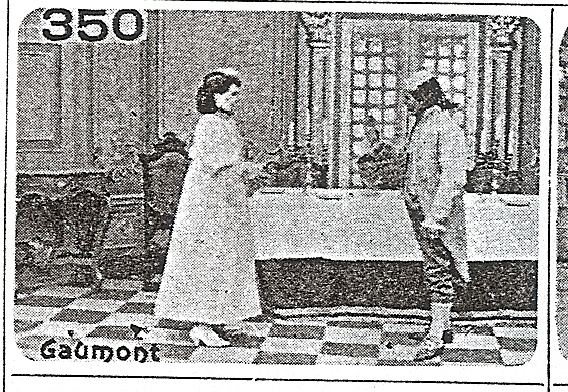 El Husar de la Guardia
El Husar de la Guardia
The sound films that Guy shot in Spain in 1905 were not released until 1906 and appeared in the catalogue as follows:
340 La Gatita Blanca. "Machicha". In Spanish. 49m.
341 La Gatita Blanca. "Couplet number 2" In Spanish. 46m.
342 El Husar de la Guardia. Duet in Spanish. 55m.
343 Gigantes y Cabezudos. Duet in Spanish. 64m.
344 La Viejecita. Duet in Spanish. 60m.
345 El Amigo del Alma. Duet in Spanish. 60m.
346 Chateau-Margaux. Valse Chantee 75m.
347 El arte de ser bonita. In Spanish. 45m.
348 Las Carceleras. 69m. In Spanish.
349 La Tempestad. 60m. In Spanish.
350 El Husar de la Guardia. Number 2. In Spanish. 63m.
351 Nina Pancha. Sung by Mme Lina Landi. In Spanish.
352 El coro frigio. 81m. In Spanish.
This is how Alice Guy describes her time in Barcelona:
The director of our affiliate in Barcelona had a charming wife who extended hospitality to me for several days. One of our clients, “Napoleon,” who had met me in Paris which he visited frequently, had prepared a grandiose reception for me. I was, thanks to him, received on board a warship where the officers, after having offered me refreshments, led me on a tour of their ship and invited me to their table where a superb bouquet of camellias awaited me.
One can only wonder if by “Napoleon” she is referring to Ricardo de Baños. But we will probably never know. Soon after Alice Guy’s visit, Baños started his own film company, and in 1908 made this film of Barcelona:
Alice Guy didn’t like Barcelona, but she loved Monsterrat:
After visiting the city, very fine but rather banal with its houses too modern, too rich, with rectilinear avenues and shade-trees still too young, we made the famous pilgrimage up Montserrat. Many Spanish pilgrims climb on their knees, up the mountainous road cut by stations of the cross, leading to the Benedictine monastery where one find the miraculous Virgin of the “nuevos,” the newlyweds…. The site itself was very fine. Anatole took many shots of it.
One of the views of Monsterrat is included in the clip below. I was very moved to find that Alice Guy had remembered her single trip to Monsterrat so well, as I when I lived in Spain as a child I made the pilgrimage myself once a year.
From Barcelona Alice and Anatole went to Zaragoza, then to Madrid (the clip below starts with the Madrid clips, including Plaza Castelar, Ministerio de la Guerra, Jardín del Prado, calle de Sevilla, Puerta del Sol, Palacio Real). Then they went to Andalusia. But they were not only interested in making travel films; they also wanted to make phonoscenes of Spanish dancers. She had a list of contacts to facilitate such filming, but her first experience in Madrid did not go very well; a fight broke out amongst the dancers over a lost shawl and the films themselves don’t appear to have survived. (But it's possible that that episode actually happened in Seville; see the next entry).
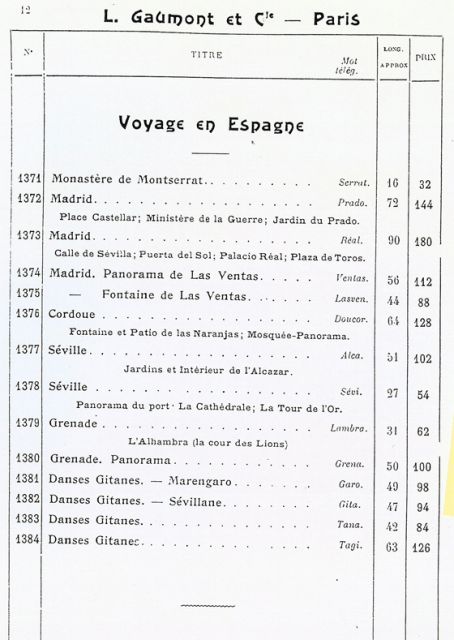 List of Silent Films Alice Guy shot in Spain, 1905
List of Silent Films Alice Guy shot in Spain, 1905
From Madrid Alice and Anatole went to Cordoba in Andalusia, and this marks the beginning of the Guy’s trip that we were able to retrace.
Our visit started June 17, 2009, when we flew into Malaga and were met by Francisco (known as Paco), who made that first hard day much easier for us, by taking us to his house, letting us shower and rest there until lunch time. We had lunch with his wife, Amor, and his three children by the beach, a wonderful way to spend the afternoon that made me very nostalgic for my own childhood growing up in a Spanish beach town many miles to the north of Malaga.
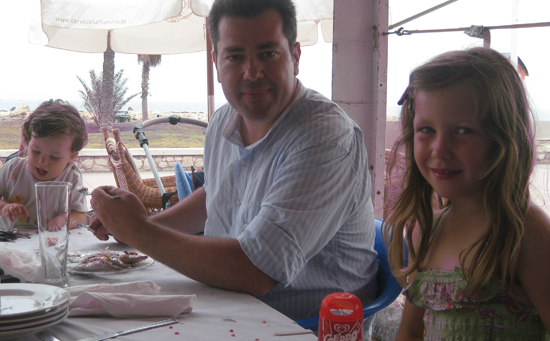 Paco with his two younger children
Paco with his two younger children
After we checked into our hotel Paco took us out for a dinner of tapas and wine and a walk around his city. We walked up to the Alcazar and down to the Roman Ampitheatre, then around the commercial area which reminded me strangely of Dublin, with its pedestrian-only thoroughfares. Griñan is extremely proud of his hometown and his enthusiasm began to communicate itself to us; almost immediately my husband Charlie and I began discussing the possibilities of living there at least part of the year.
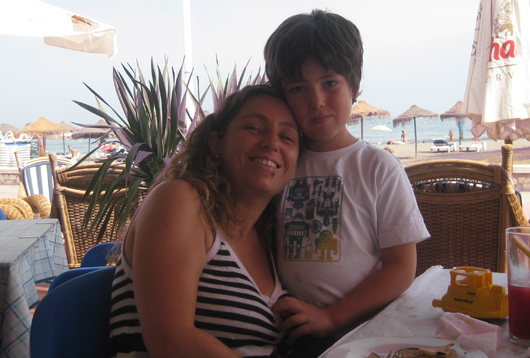 Amor and Pablo.
Amor and Pablo.
The next day Charlie and I went to Cordoba. A GPS malfunction made us arrive late, but since the sun doesn’t set until almost 10 pm we had plenty of time to walk around Cordoba and have dinner in a little patio restaurant called bar de los Deanes, on a road lined by tourist shps that leads to the Mezquita.
Just walking around the Mezquita from the outside, and along the Roman bridge to the torre de Calhorra, and then back up along the outside of the old walls, standing on tiptoe to see inside the gardens of the Alcazar, just that was enough to fill me with a sense of Cordoba’s beauty, a kind of wordless sense I could not begin to express, even though I almost had sun stroke every day.
It is here in Cordoba that I first picked up Alice Guy’s trail in Spain. For Guy, the stopover in Cordoba was just that: she took the train down from Madrid in the morning, visited the Mezquita “of the hundred columns” (she must have visited it quickly because it actually has around 815 columns left of an original 860, according to my Baedeker travel guide published in 1908). She walked along the river and across the Roman bridge at sunset and then took a train to Seville.
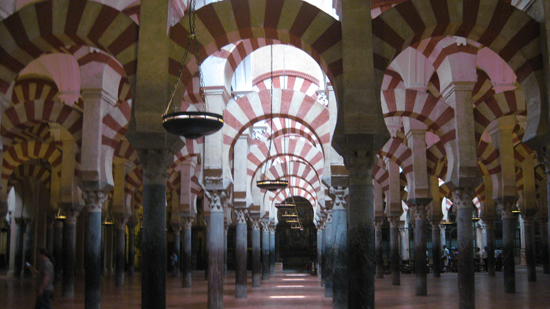 La Mezquita de Cordoba, now a Cathedral
La Mezquita de Cordoba, now a Cathedral
This is what she had to say about Cordova, as she called it:
What a pretty town with its narrow streets, its grilled windows, its patios ornamented with orange trees in flower. In spite of oneself one looked about for serenaders. But I did find the least vestige of the famous leather of Cordova.
Anatole did not share my enthusiasm at all. In the evening, as we strolled along the Guadalquivir mirroring a magnificent stunset, having in front of us the old Roman bridge beside which rose the celebrated Mosque of the Hundred Columns, I said:
“Heavens, Anatole! Isn’t it beautiful!”
He hardly raised his eyes from the ciragrette he was carefully rolling and, very calm, he said to me a bit disdainfully:
“As for me, what I see most clearly is that here I pay three cents for my newspaper!”
I could have beaten him.
But I felt myself a bit at fault, Our trip to Cordova had not been included in our voyage; it was for my personal pleasure that I had added these hours to his exile. I understood his ill humor. He had difficulties with the cameras whose adjustment was delicate and somewhat imperfect. Perhaps the Paris workshops were not entirely responsible for that. He had to carry the camera most of the time. He was tired of the rather monotonous cuisine… rice with chicken, rice with fish, rice with shrimp. The hotels where we stopped were not irreproachably clean. The streets, where women combed or de-loused their magnificent hair before their doors, where children slept almost naked on the sidewalk, their eyes fringed with flies, smelled strongly of fruited oil. And one grows quickly tired of dried peas and tourone.
It was only after being in Spain a couple of days that Charlie and I realized the rice-and- whatever that Anatole was complaining about was paella. It is true that in Cordoba at least there is not much else to choose from: tapas or paella, paella or tapas, paella as a choice among tapas. But always excellent! We could not imagine why Anatole would complain.
It was hard to reconcile the naked children sleeping in the doorway with Alice Guy in a winter hat and coat just a few days later in the trip in Granada, as Anatole filmed her, surrounded by children (the footage is in the clip above). And the image of the women in the doorways, was that something she saw all over Spain, or just in Cordoba? We might never know.
Fortunately, no one ever offered us dried peas.
I referred to my Baedeker and tried to imagine the Cordoba that Alice Guy saw. Baedeker says it had just over 50,000 inhabitants in 1908. Alice and Anatole would have arrived at the the train station that handled the Madrid, Seville, and Malaga trains, which is just north of the bullring and at the top of the Paseo de Capitan, at the time the main shopping and nightlife street.
They might have taken a one horse cab down to the Mezquita, since they had so much to carry, unless they checked it at the train station. The ride would have been a peseta, with extra for the extra baggage. Once at the Mezquita (now a cathedral) they would have bought a ticket at the Puerta del Perdon, a different door from the one we went into. They probably did that straight away because it closed at 5 pm.
Then they ate something, probably paella, searched among the gift stores for leather and found none, and knowing they were about out of time went down to the river, walked toward the jardines del Alcazar (palace), which at the time was a prison, so not the tourist attraction it is today, and then walked back a little; or they might have walked all the way around, as Charlie and I did our first day, and walked up the outside walls, which would have put them through the Jardines de la Victoria, which Baedeker says not to miss.
Eventually this would have led them to the train station where the train to Seville took three and a half to five hours, depending on which one they took. The train follows the Guadalquivir River, through some pastures that train bulls for the bullring, through some orange groves, through lots of farmland that still looks the same today. She would have passed Pedro the Cruel’s treasure house, past a town with four bell towers. Still following the Guadalquivir most of the way she would have seen olive groves, orange groves, some barren land, then pulling away from the river although you could still see the high reddish banks off to one side, she would have finally pulled into Seville. Baedeker quotes Gautier, who said the Cathedral looks like an elephant surrounded by a herd of sleeping sheep. But I will save my report on Alice’s Guy’s adventures in Seville, Granada, and Gibraltar for my next entry.